Montessori Pathways' News
January, 2012
Notes from Miss Alena
I would like to start off by extending a warm welcome to three new students: Kyra, Anshu, and Cooper. Welcome to our Montessori Pathways family!
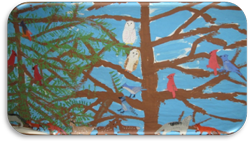
After a very hectic December, we were able to slow down a little in January. The month started with our Parent Evening on the interrelation of language and science. There was a lot of new information presented on the relationship between the two areas and it was great to hear parents relating back how they’ve been applying this information in their homes.
I would really like to share a moment from our Montessori classroom with you. One afternoon, during snack time, the children were sitting on the line and finishing their snack. One of our students warned the kids next to her that if they continue to be very active, they will knock over her cup with water (which indeed happened not even moments after her warning). My initial, instinctive reaction was typical of any adult--the "uh-oh, now what?"
The child's response to my reaction with her eyes
(“What's the big deal?”) was awe-inspiring. She then stood up and said,
"Not a problem. I can get a floor cloth," which she proceeded to do. After she successfully cleaned up the area, she looked at me and proudly said
"What's the problem, Ms. Alena?" All I could think was "love it!!!!" There were no bounds to my excitement!
This is exactly what the Montessori environment strives for: the ability to easily solve any problem and have a sense of self-confidence.
I also wanted to share a personal story of Montessori being seen in the home. The kindergarten club had been voting on a name for a new snowy owl that was moved to the Lincoln Park Zoo. Alex decided to share this news with us. But when we asked him more information about the owl (Where was it born? How old was it?) he did not know, and left for a while.
He then returned with more specific information and when we asked him where he found it, he said “It was easy. I just looked on Google.”
I’m lucky that I can observe my child not only as a mother, but as a teacher, which reassures me each time that the Montessori Method is what our children need. This drive to search for information is something that is supported with the Montessori Method.
In a Montessori class, children are not simply fed information from the teacher, but learn how to find the necessary information that is interesting and important to them. This research skill starts to develop in the Primary (ages 3-6 ) class and is the main focus of the Lower Elementary, because this is an important skill in today’s society.
Although I never taught him how to look up information online, he learned through observation and was able to utilize it in order to find answers that were of interest to him.
Another day, when watching a Disney Channel show, he heard the words “whole” and “hole” and said “Did you know those are homonyms?” To my knowledge, this is part of the elementary curriculum, but as he said, they were learning about them in kindergarten club. Not only was he able to retain the information, but also apply it, which is specific to the Montessori Method.
It is so sad that I could not have a chance to be a Montessori student, but I am so happy that my son can.
Warmly,
Miss Alena
Working with Montessori materials:
The Snake Game
The Snake Game is a Montessori math material that introduces the child to the concept of remainder. A child who has worked extensively with a work called handful exchange is presented with The Snake Game. Handful exchange gives the child a concrete activity to practice changing 10 ones into 1 ten, 10 tens into 1 hundred and 10 hundreds into 1 thousand. This concept is often taught in traditional schools as carrying when doing an addition equation. Handful Exchange gives the child the understanding behind why we are carrying in a very hands-on way.
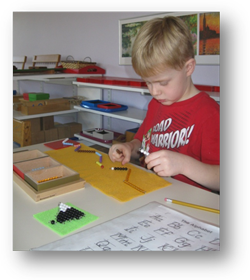
The Snake Game begins with a child laying out a horizontal free form “snake” using the colored number bead bars.
The child will also set up a special set of remainder beads that she will use as she proceeds with The Snake Game.
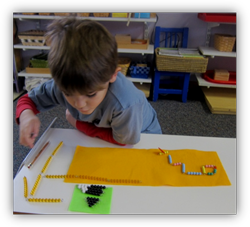
The child begins on the left side of the snake and begins to count each individual bead, when she gets to ten she stops. She places her counter upright wherever she stopped within the colored bead segment. She then gets one gold 10 bead bar to exchange for the ten she just counted. Then she counts the remainder of the colored beads within that segment to the right of her counter, this is her remainder. She finds the correct remainder bead from her remainder beads and places it with the golden ten bar. She removes the counted colored bead bars and then begins counting again from one, beginning with the remainder bead. She continues on counting to 10, exchanging and finding the correct remainder until she had transformed her entire colored snake into a golden snake. If a remainder exists, it is the head of the snake.
The Snake Game is usually presented to children in their third year (Kindergarten) as they have the focus and fine motor skills to manipulate the materials with ease and have grasped the concept of exchange. This hands-on approach and very visual approach allow the children to really understand the mathematical concepts of exchange and remainder.
More advanced versions of The Snake Game (multiplication, division and subtraction) are introduced in the Montessori Elementary classroom.
Miss Jocelyn
Working with Montessori materials:
Roll Work
Roll work is one of several activities on the shelf which highlights the decimal system and place value.
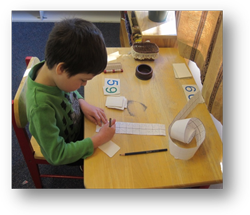
- The child begins by setting up the “bank”. The bank consists of ones, tens, hundreds, and (rarely) a thousand.
- The child then can take one bead from the bank for himself.
- He sets the numeral one next to his bead, representing the quantity he “owns”.
- He records how much he has on special place value paper in designated colors.
- He then can take another bead from the bank for himself, turn over the old number, get the new number which represents his quantity and record the new number.
The child repeats the process “forever”.
OBJECTIVE and POINTS OF INTEREST FOR THE CHILD:
- Numbers never end. You can always add one more.
- The child sees the value increasing.
- The child keeps track of place value.
- The child will exchange periodically (10 ones exchanged for 1 ten, 10 tens exchanged for 1 hundred, etc).
- This is the equivalent of actually “carrying” value into the next adjacent place value. But he can do it with actual materials instead of just pencil and paper.
Miss Karen
Notes from the North Classroom:
Miss Jocelyn and Miss Christine
After coming back from a not-so-snowy winter break, we finally were able to enjoy some snow outdoors to go along with some of our new activities related to snow inside the classroom. Snowflake tracing and painting, snowflake folding and cutting, paper mitten lacing and the snowflake memory game are fun new works that we put out this month for the children to discovery and explore.
In the Science area, a new work focused on how animals in the wild survive in winter. The children were able to match animal picture cards to determine which animals hibernate, migrate and adapt. We also read some fun books about hibernation: Hibernation Station and Old Bear.
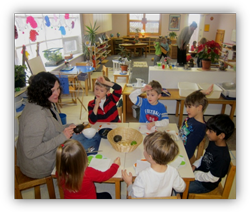
For our tasting activity this month the children had the opportunity to use their senses to explore the fruit, avocado. In small groups, the children used their sense of touch to decide if the outside peel was rough or smooth and then compare the touch of the outside to the inside flesh.
They used their sense of sight to describe the color of the outside peel (one child called it blackish, greenish, brownish) and then compare that to the inside color (another child called it spring green). The discussion and activity of exploring the fresh fruit or vegetable during these tasting activities provide the children with practice making predictions and providing detailed descriptions. The children in the group then helped to mash up the avocado and then scooped some on their cracker to taste. After the activity, the remaining avocados were then served with our lunch and none was left over!
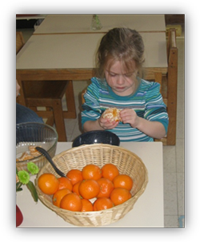
We added a new small group activity this month, a smelling activity! A smelling activity is organized in much the same way as a tasting activity; however we focus on the scent in order to build awareness. This month we compared and contrasted the scents of a fresh lemon and a fresh lime. The children then took turns squeezing the citrus fruits over sliced apples that were to be served for lunch. Squeezing of a half lemon or lime is an excellent activity for a child to build up hand muscles for writing. Thank you to all of our families who provided the fruits for these activities this month!
Our classroom is busy in Practical Life area with activities that offer experiences in honing fine motor skills such as sewing fleece pillows. The children eagerly wait to participate in this work and it gives them something concrete to complete and bring home. It takes lots of vocabulary as well as endurance to finish.
First, they choose their fleece pattern and thread color. Next they learn how to insert the thread through the eye of the sewing needle and tie a knot at the end (also a good skill as a precursor for shoe tying). The edges of the fabric need to be held together evenly and the needle has to be put through both thicknesses of it; this can be quite challenging to do as it does take some physical hand strength.
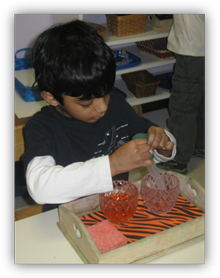
Next, the process of sewing over and under is a pattern that requires coordination and fully engaged concentration. The children learn to sew three sides of the pillow and leave one side open so that they can stuff the pillow with the filling - this is the most rewarding part as they love to dig their hands in the bag with the batting and choose how fluffy their pillow will be. Lastly, we close the final edge and the final product is laid on the table and everyone takes a turn laying their heads on the newly created pillow!
Other fine motor activities we're focusing on include transferring colored water with a baster and then with an eye dropper.
The children enjoy this routine of choosing the water color, transferring (squeezing and releasing helps to strengthen hand muscles which are needed for writing) and the process of emptying the containers when complete.
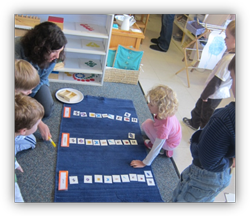
As usual some of our favorite winter activities include baking and ironing our napkins. These are homey and comfortable tasks that enable the children to participate in taking care of our school environment and sharing with our school community. The sense of accomplishment and pride in a task well chosen and completed are key factors in their self confidence/self reliance.
Finally, we closed out the month with some fun activities to celebrate Chinese New Year 2012, the year of the dragon. The children had the opportunity to make a red Chinese lantern and a hand-held dragon sign. These activities provided the children with practice using a ruler to make straight lines, cutting with accuracy, taping, hole punching, tying and writing.
Miss Jocelyn and Miss Christine
Notes from the South Classroom:
Miss Karen and Miss Ambreen
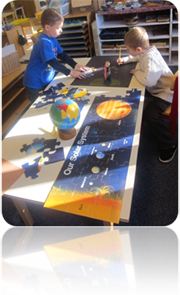
Thank you:
• To Elizabeth’s mother for home-made Chinese dumplings. Yes they were truly delicious and the children loved them. They were followed up by a tasty home-made chocolate cake.
• To Malcolm’s family for the brine shrimp. This will be an experiment for all of us. We need to set up a special environment and watch these “pets” grow. We have been promised replacements should something go wrong.
• To Kendall’s family for the snow block building equipment. We look forward to making igloos, forts, etc. All we need is the ingredient ---more snow.
• To our garden moms. They have volunteered to turn into “snow moms” as soon as we get the snow.
• To the parents who attended the language/science evening (a brief summary below)
Special visitor:
We were happy to welcome Ann, Malcolm’s grandmother. She came to us all the way from Croatia! Hope you continue to enjoy your time in the United States.
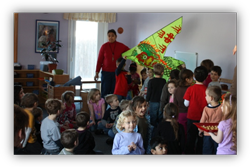 A Dragon’s appearance:
A Dragon’s appearance:
In honor of Chinese New Year, we had a special dragon parade. We all held onto our LONG dragon kite and, accompanied by Ambreen playing the rhythm, we paraded into Miss Jocelyn’s class chanting “Happy New Year” in Chinese. We also brought a gift of a tray of fortune cookies. Miss Ambreen brought cookies for our class also, along with oranges, a symbol of good luck.
The Smell of Home-Made Cooking:
Yes, in the middle of the month, the aroma of home-made soup permeated the air. Children were busy for 3 days peeling and cutting onions, celery, carrots and potatoes for our “hamburger soup”. By all accounts, it was a delicious success. Several children had three servings. We shared with Miss Jocelyn’s class. Home-made soup on a winter day is pretty special. It is really special when we have made it ourselves.
Language evening: Below are just some of the highlights of information
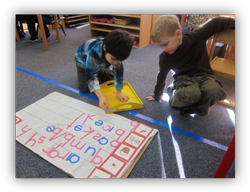 Main points:
Main points:
1. Language is power!
2. Language ability is a predictor of success in later grades.
3. Naming objects and qualities bring them into the awareness of the young child.
4. The young child has an absorbent mind. He learns language effortlessly!!
Role of the adult in fostering language.
We need to create an environment rich in language. We can do this in a number of ways:
1. Read books in an interesting, expressive way.
2. Let your children see YOU reading books.
3. Intentionally use adjectives and adverbs in speaking with your child.
4. Expand our ideas of language as related to a particular subject. We broke into groups. One parent group came up with over 40 appropriate vocabulary words that related to using a globe (ex. equator, continent, names of landforms, longitude, migration, etc. etc. Another group did the same with generating vocabulary related to trees.
5. Preposition words are one basis for mathematical thinking, so we need to give them special important: over, under, next to, after, before, between, etc.
Miss Karen and Miss Ambreen
Kindergarten Extended Day
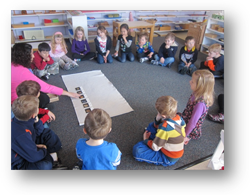
Upon returning from winter break, the Kindergarteners began their study of our place in the universe and the planets of the solar system. After learning the names and order of the planets, the children then discovered that some planets have similar attributes and could be organized by these attributes. The four planets closest to the sun are smaller, made of rocks and metals and have no rings, while the four planets farthest from the sun are larger, made mostly of gases and all have rings. The children have really enjoyed this area of study and many have gone home to research more about the solar system and then come to school to share the information they have discovered with the other Kindergarteners!
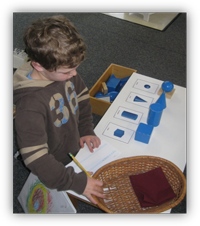
As an extension to learning the solar system, the Kindergarteners have spent several weeks creating their own 2-D solar system. This big multi-step project not only is reinforcing the information they have learned about the planets it is teaching them the valuable skill of how to break down a big work into smaller manageable steps over a series of many days.
The Kindergarteners this month also are learning about different geometric solids including the sphere (like the planets!)
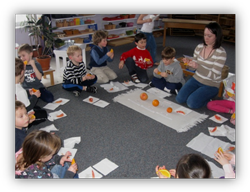
In addition to working with the Montessori geometric solid materials, Ms. Katy presented a special tasting activity using three different citrus fruits: clementine, orange and grapefruit. The children compared each by size, color, shape, texture, scent, weight, sound and taste. The consensus was that these spheres were delicious!
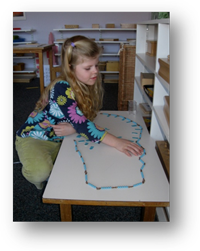
In Math, the Kindergarteners are busy working with the long chains from the Montessori Bead Cabinet. This advanced work builds a child’s skip counting skills while focusing on the important ideals of concentration, organization, coordination and independence.
The long chains in the Bead Cabinet represents the quantity associated with the cube of that number; the short chains represent the quantity associated with the square of that number. These skills are foundational for the Kindergarteners work in the Montessori Elementary classroom next year.
In preparation for a field trip the Kindergarteners will be attending in February, Ms. Katy began reading one chapter a day from the novel, The Chocolate Touch. The children are working as a group to listen for meaning, draw conclusions, make predictions, summarize the action and describe the characters. When listening to a read-aloud chapter book the Kindergarteners are expanding their imaginations to make pictures in their mind as they listen taking the next step in their reading journey.
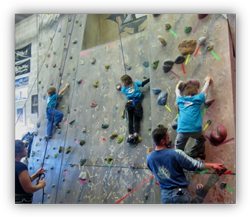
The first January field trip for the Kindergarteners was an active afternoon at North Wall Rock Climbing Gym. The children were able to try top rope rock climbing, tightrope walking, bouldering and visiting the “lizard cave”. All of these gross motor skills helped every child to build confidence in their abilities, stretch their bodies and slow down to achieve balance. All of the children tried every activity and were sad when it was time to go!
Our second January field trip is actually happening this upcoming Friday at the Prairie view Nature Center. The Kindergarteners are participating in a program called Animals in winter to learn more about animals that hibernate, migrate and adapt and then take a winter hike with a naturalist through the nature preserve to look for signs of animals.
Miss Jocelyn
Notes from the afternoon classroom:
Miss Terri
This certainly was a unique month as far as the weather was concerned. The afternoon January temperature went from sunny and 58° to snowy and 35° within a couple of days. We decorated the wooden train on the playground with beautiful, chalk pictures one day and the next day we were shoveling snow into a snow hill. It was amazing.
I highly recommend buying a child’s size snow shovel if you don’t already have one. We have had many hours of fun outdoors using our muscles and this simple tool! It may take a while to dress for the outdoors as far as snow clothes but it worth it. In fact, I think our little snow-hill had a “boy magnet” buried in it. Every time I look at it, the snow-hill has about a dozen boys rolling or laying on it. It’s been great!
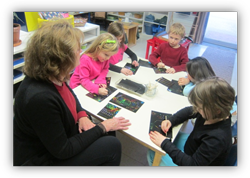
Art this month has involved using several different mediums. We have been enjoying drawing on scratchboard paper with wooden sticks. It’s so fun to see the colors magically appear. First, we practiced making patterns on one paper – diamonds, checkerboard pattern, stripes, circles, squares and more – then we drew pictures of our houses on another. We all ended up with rainbow colored yards and houses. For our next project we again drew houses using square and triangle insets for the frame. We added windows, doors, chimneys etc. to make our houses complete. Then we outlined our drawings with markers, colored them with craypas then finished them off with watercolors. It’s always fun to see the water-resist effect with craypas as the watercolor doesn’t stick to the colored clouds, sun and trees.
Our large group project this month was a winter mural. First, we painted a winter blue sky and brown tree trunks with tempura paint. Each tree was painted as if we were inside looking out through the bare branches - or in the case of the pine tree, through the pine needles. We are now in the process of making all kinds of winter animals to add to our mural.
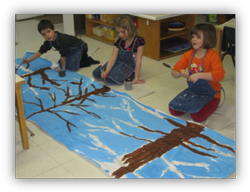
Some of the animals we have made so far are foxes, wolves, cardinals, blue jays and owls with plenty more to come. The animals are drawn, then colored and finally poked out of colored construction paper.
Some of our snacks this month have included apples, clementines, grapes, bananas, banana bread and popcorn. We particularly enjoyed making home-made pretzels for our baking projects. The smell of the yeast in warm water was new to most of the children. We were amazed to see the dough double in size before we kneaded it. While the texture was different, it was a lot like kneading the play dough we made for art. We pressed it, folded it, pounded and rolled it before dividing it into about 32 small bowls (it was a little math project as well!) Then, we rolled out the dough and made twisted shapes, hearts, rings and more. It was so much fun! The pretzels were then brushed with egg and water before baking. We definitely want to make this recipe again!
Designer Pretzels
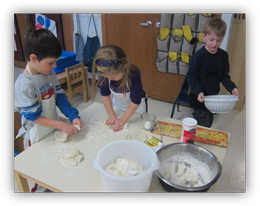
Ingredients:
1 ½ cups warm water
1 pkg dry yeast
1 tbsp sugar
4 ½ cups flour
Topping ingredients:
2 tbsp water
1 egg
coarse salt, poppy or sesame seeds
Getting ready:
1. Put the 1 ½ cups of warm water, yeast and sugar in the large bowl. Let it sit for 5 minutes.
2. Stir in flour and mix well, first with the spoon, then with your hands.
3. Put extra flour on the counter, turn out the dough and knead about 20 times by folding the dough over onto itself. You can bang it, slam it, give it a good karate chop.
4. Put the dough back in the bowl, cover with the towel and let it rise in a warm place for about 1 hour until double in size.
5. Divide the dough into 20-30 balls, about the size of a golf ball. Use extra flour on your hands if the dough is sticky. Roll out each ball with your hands into a long stick as thick as your thumb.
6. Shape them into hearts, stars, snails, fish, pretzels, initials—anything!
7. Turn the oven on to 400oF. Place all your creations on cookie sheets.
8. Use a fork to mix the egg and water together in a bowl and brush on the pretzels with a pastry brush.
9. Sprinkle with coarse salt, poppy or sesame seeds or leave plain.
10. Bake about 20-25 minutes until hard and brown. Cool on a rack. If you want more bread-like pretzels, bake them for only 15 minutes (but they won’t keep as well).
Here it is, hope you enjoy. Special note: We baked out pretzels for 15 minutes instead of 25 so they stayed nice and soft.
Miss Katy
The Nappers came back from Winter Break and eased right back into the routine of their normal day. The children continue to practice good manners and are now reminding one another of when to say “please” and “thank you”. On a daily basis we are practicing talking and listening skills. The children are either asked a question such as, “What is one fun thing you are going to do this weekend?” or “What did you have for dinner the night before?” Sometimes I simply ask the children if they have something they want to share (which they all do!). We then take turns, one at a time, sharing and listening to the answer. This is a wonderful way for the children to practice their listening and conversational skills.
Our activities this month started with thinking about a common cold weather animal: the penguin. We made paintings of penguins using potatoes as stamps. The children were not only able to learn penguin facts, including parts of the penguin, but they also were able to notice the characteristics of a potato.
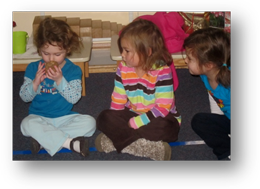
The Nappers then spent a week working with watercolor paints. Our first day, we worked on keeping the colors separated in the paint tray. The second day we did a crayon-resist using white crayon. The children found it interesting that the white crayon appeared once they applied the watercolor paint. On the third day we soaked our paper in water, applied water color paint and then shook salt on top of the wet, colored paper. The next day we checked our art and discovered it produced an interesting and colorful texture. The children fastened their work together as a book of watercolor art.
During the last part of the month, we began talking about the Arctic. We used an atlas and a globe to figure out where the Arctic is located. The Nappers learned about the different types of animals that live in the arctic.
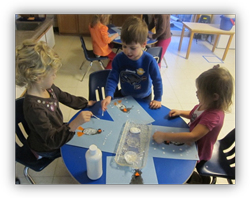
We made polar bear faces using cotton as fur. The children worked cooperatively to pull apart the cotton balls to create a more realistic version of polar bear fur. Next we talked about the Arctic wolves. We looked at photographs in books to see the different colored layers of fur that the wolves have. We used colored pencils to practice a layering technique to display the different colors of fur the wolves have. The last animal we worked on was the Arctic fox who’s fur turns completely white in the snowy months. The Nappers pin poked out the form of an Arctic fox (which is an excellent use of small motor skills in preparation for writing). We glued them on snowy paper and noticed how well they blended into their environment.
We are currently finishing up our exploration of the Arctic with one last project. The children are very excited about what they have created. Look for it to come home within the next week or two!
Miss Terri and Miss Katy
Gym Class with Ms. Donna
We have been working on keeping our bodies moving for a longer period of time and playing more games. Sleeping Giant begins by the children jumping up and down until they hear "Sleeping Giants!"Then, they collapse to the floor and lie very still. When they hear "Waking Giants!" the children start jumping again.
Number Ball has us standing in a circle passing a ball around. The first child counts, "One" out loud, and as the children pass the ball to the next person, they say the next consecutive number. We reached up to 55.
Through the Hoop teams have a hoop, the first player goes through the hoop and then gives the hoop to the next person in line, then they go to the end of the line, etc.
Buckets is another game, we used hoops to hold the primary and secondary colors. Colored papers were scattered all over the floor. A movement was called out and the children then selected a colored paper and put it into the correct hoop. We put folding mats on the ground, then the children would stand on the mat and then jump off as this was mastered we tried jumping over the mats (low hurdles).
The kinders played a game called "Swamp", two teams, 2 alligators on scooters and lots of balls. If the balls landed in the swamp the alligators would collect them and put them in their team baskets. Balls could also be put in to the team basket if a team player caught a fly ball. When all balls were in baskets new alligators were chosen and the game began again.
Human bowling pins was also played. Two teams each with a soft ball would roll the ball at the children who were acting like bowling pins; however, these pins could move to avoid being hit by a ball. When a child was hit they would trade places with the person who had hit them with the ball. The tricky part for the human pins they had to always be looking for a ball because they could come from both directions.
Miss Donna
Gym Class with Ms. Donna
March had us continuing our loco-motor skills, as well as throwing and catching a ball with a partner. We also began leaping or jumping over folded mates and jumping over the long jump rope as it was wiggling on the floor.
Stations were introduced this month. Children were assigned a station for a certain amount of time. When time was called they had to make sure that their station was set up for the next group before they could move on.
The stations were ski jump (you jumped over a jump rope on the ground keeping your feet together), throwing bean bags underhand and overhand into a small ring inside of a hula hoop, scooter trail (following a path while sitting on the scooter just using your legs and then following the path laying on the scooter using your arms and legs, and our last station was crawling through tunnels.
Miss Terri and Miss Donna
